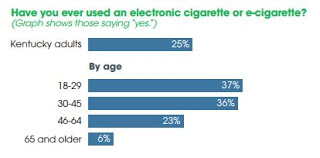1/4 of Kentucky adults, 2/5 of those 18-45, have used e-cigs

Kentucky Health News
One in four Kentucky adults have ever tried electronic cigarettes, with the largest percentage of those reporting use between the ages of 18 and 45, according to the latest Kentucky Health Issues Poll.
The poll, taken Sept. 11 to Oct. 19, found that almost 40 percent of Kentuckians 18-45 had tried e-cigarettes, compared to 23 percent between 46 and 64 and only 6 percent of those 65 and older.
E-cigs are battery-powered devices that deliver nicotine through a vapor by heating a solution of propylene glycol or vegetable glycerin, flavoring and other additives. The use of such products is commonly called “vaping.”
Vaping more than doubled among Americans 18 and 24 from 2013 to 2014, the latest data available, according to a December report from the Office of the Surgeon General, its first on e-cigs, which it called a “major public health concern.” It said the brains of youth and young adults are more vulnerable to the negative effects of nicotine exposure, including addiction, reduced impulse control, deficits in attention and learning and mood disorders.
“Research suggests that e-cigs may be a gateway to using other forms of tobacco, and they can be just as harmful,” said Ben Chandler, president and CEO of the Foundation for a Healthy Kentucky, which co-sponsored the poll. “They expose users to toxic chemicals, including nicotine, which long has been proven to be addictive and responsible for a wide range of health issues. E-cigs are simply not a safe alternative to smoking, especially for young adults and nonsmokers.”

The poll found that e-cig use was highest among current smokers, at 61 percent. Seven percent of lifetime nonsmokers and 21 percent of previous smokers reported they had ever tried them.
It also found that e-cig use was 74 percent higher in Kentuckians with lower incomes, with 33 percent of those at or below 200 percent of the federal poverty level saying they had ever used them, compared to 19 percent of those above this level. Cigarette smoking is also higher among lower-income Kentuckians.
 The poll also asked about the safety of e-cigs compared to tobacco cigarettes and found that 45 percent of Kentucky adults thought there was no difference; 29 percent thought they were safer; 19 percent thought they were less safe and 7 percent didn’t know.
The poll also asked about the safety of e-cigs compared to tobacco cigarettes and found that 45 percent of Kentucky adults thought there was no difference; 29 percent thought they were safer; 19 percent thought they were less safe and 7 percent didn’t know.
Advocates for e-cigs claim they are a way for smokers who don’t plan to quit to smoke in “smoke-free environments,” that they are safer because they have fewer chemicals and carcinogens in them and that they can help smokers quit, but this claim has not been proven.
“In our product you have nicotine or no nicotine, PEG, and some flavoring. In cigarettes you have nicotine, PEG, and 4,000 chemicals and 43 carcinogens,” CraigYoungblood, president of the InLife e-cig company, which makes no health claims, told WebMD. “There are 45 to 50 million people already addicted to nicotine. Should they have the choice to satisfy their addiction by other means? … I am a proponent of harm reduction. People have rights and choices and should be allowed to make them.”
But the U.S. Food and Drug Administration, along with many health experts, say there hasn’t been enough research done on the long-term health effects of these products to determine their safety and that research, to date, does not support that they help people quit.
The Kentucky Center for Smoke-free Policy says e-cigs have known carcinogens in them, including nitrosamines and formaldehyde. It also notes in its e-cig fact sheet that the lack of regulation on these products hinders research about safety and efficacy because the products keep changing. The FDA is working on regulation requirements for them.
The health foundation’s news release about the poll notes that the number of Kentuckians who have ever tried e-cigs remains statistically unchanged from the last time the poll asked the question, in 2014.
The poll was funded by the foundation and Interact for Health, a Cincinnati-area foundation. It was conducted by the Institute for Policy Research at the University of Cincinnati. It surveyed a random sample of 1,580 Kentucky adults via landlines and cell phones. The margin of error for results involving the whole sample is plus or minus 2.5 percentage points, and larger for smaller samples.
